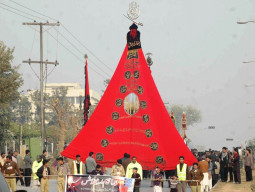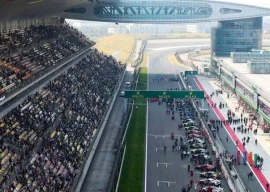
Posts by some militant outfits on social media about Iran indicate the presence of an ideological lobby inside Pakistan, which opposes improvement of bilateral relations between the neighbours. It also gives an impression that the matter is nothing, but an ideological confrontation. But was this always the case?
Though the literature by the Pakistan military appears silent on both Saudi Arabia and Iran, Tehran was once a significant capital that ensured Pakistan’s security. Generals like Ayub Khan, Yahya Khan, Nur Khan and others appreciated Iran’s worth for Pakistan. There is enough evidence that speaks volumes about Iran’s centrality for Pakistan’s security, especially up until the late 1970s. The Shah of Iran had provided material help to Pakistan during the latter’s 1965 war with India and was looked upon to admonish New Delhi for any adventurism. In 1969, Pakistan celebrated the Iranian monarchy and Iran celebrated Pakistan Day. The then governor of Sindh, Vice Admiral, SM Ahsan, stated: “Pakistan and Iran are twin brothers.” Did all of this change during Ziaul Haq’s decade in power and just because of a particular religious ideology?
Indubitably, Zia’s era had a major role to play. The rise of the jihad culture changed Pakistan’s socio-political dynamics. One of the important milestones in our history is the creation of the Sipah-e-Sahaba Pakistan that was encouraged and later established in the 1980s, not just to fight the jihad in Afghanistan, but also to start a sectarian conflict in Pakistan. Zia was uncomfortable with those sects in Pakistan which were resisting his Islamic laws, especially as these affected them. The Iranian Revolution in January 1979 made Pakistanis belonging to these sects overconfident about pursuing their ideology and challenging Zia’s laws. The state resisted harshly. By the mid to late 1980s, there were enough forces present to punish people based on their sectarian identity, for instance, for demanding a separate curriculum in their schools in Gilgit-Baltistan (G-B). That a lashkar went to G-B, which was involved in sectarian violence, is a fact of history. Many of the lashkaris settled in G-B to change the environment permanently. This was the typical reaction of a security establishment, which is sensitive to internal challenges and deals with these heavy-handedly — be it in East Bengal, Balochistan, G-B or Okara.
But in 1979, the Pakistan-Iran relationship was not yet confrontational. In fact, for the military regime’s Jamaat-e-Islami (JI) partners, the Iranian Revolution reflected Maulana Maududi’s political philosophy, which certainly had an impact on Iran’s revolutionary leadership. In 1978, Zia’s minister JI’s Khurshid Ahmad insisted on meeting Ayatollah Khomeini in Paris whom he finally met on January 14, 1979. It seems that the flow of American money then changed everyone who had established a jihad shop for Afghanistan.
However, Pakistan’s state remained ambiguous towards Iran, which it considered the source of an internal irritant, yet a ‘brotherly Islamic state’, whose military arm ought to be strengthened. The transfer of nuclear know-how, which is a recorded fact, was the brainchild of the generals’ ambitions to counter the US by propping up forces that would counter American hegemony in the region. Islamabad also helped Tehran in missile and other technology transfers from China. Even as late as 2002, a senior general of Pervez Musharraf’s team warned a high-level visitor from Iran about Pakistan and Iran’s common threat, the US, and that it would target Pakistan’s nuclear programme after it is done with Iran.
The two decades of militancy certainly had an impact, but a more critical role was played by how Pakistan’s strategic masters envisioned regional geopolitics in which Pakistan had a central role to play. It certainly had no place for other states, such as Iran, challenging Rawalpindi’s control in its sphere of interest, like in Afghanistan. Having given favours like transferring nuclear know-how, Iran was expected to conceding to respect Pakistan’s strategic ambitions. Tehran’s intervention in Afghanistan irritated Rawalpindi. In the late 1990s, I remember naval officers cribbing about Iran being undependable.
Perhaps, the shift in Iran-Pakistan relations was inevitable given the changes in Pakistan’s strategic depth vision that evolved during the mid-1970s, relying more on its own capacity than other states. By the early 1990s, from Islamabad’s perspective, roles had reversed. In any case, Islamabad saw the Shah embroiled in his own battle with Iraq on the Shatt-al-Arab and not on the same page with Pakistan. The Shah himself was disillusioned with an ally, which was focused more on its battles with India than helping Tehran add to its geopolitical strength. In any case, Iran’s 1979 revolution and confrontation with the US made it totally unusable from Pakistan’s strategic perspective.
In the 1970s, Pakistan began to develop two key components to gain military strength — proxies and nuclear deterrence. The proxies were used aggressively in Afghanistan and then elsewhere. The security establishment was inspired by Zulfikar Ali Bhutto’s vision of finding a central place in geopolitics of the Muslim world. Pakistan would not make the mistake of not developing military capacity, which the Shah lacked to fill the strategic gap created due to withdrawal of British forces from the region. The Beg-Gul doctrine of the 1990s enunciated Pakistan’s role in filling the gap created by perceived withdrawal of the US and other forces from the Middle East. The strategy highlighted both proxies and nuclear weapons as the military’s strength.
The proxies came with an expensive ideological baggage. The murder of an Iranian diplomat in 1991 was part of the high cost, which the state was willing to pay. This was a rare case in which evidence was available to punish the killer, who was eventually freed in 2011.
Nuclear deterrence, on the other hand, boosted Pakistan’s confidence regarding its role as defender of the Muslim world. Thus, the GHQ’s disappointment over Iran’s role in Afghanistan and it building ties with India, all of which went against Pakistan’s vision.
Today, the poor state of the road from Quetta to the Sistan border underscores Iran’s marginal relevance for Pakistan. Iran, which was once Pakistan’s major trading partner, has little economic role. The American embargo, the power of internal ideological partners and the regional power games have changed the ties to a degree that they will not improve without a major shift in thinking.
Published in The Express Tribune, November 27th, 2014.
Like Opinion & Editorial on Facebook, follow @ETOpEd on Twitter to receive all updates on all our daily pieces.
COMMENTS (25)
Comments are moderated and generally will be posted if they are on-topic and not abusive.
For more information, please see our Comments FAQ


















1713264570-0/Tribune-Collage-Feature-Images-(9)1713264570-0-270x192.webp)

























Sectarian conflicts in Pakistan happend partly because of Zia also but more it was exported to Pakistan by Iranian revolution. Khomeini wanted to expand his brand of Islam to Pakistan in a similar manner as he did in Iran--shooting and killing opponents. Ayesha Siddiqa is not correct in this regard when she puts blame on Zia but does not even dare to mention Iran. Who funded and still funding TNFJ, who is supporting insurgency in Balochistan. It's irony and unfortunate that we have so called scholars who don't see the issue in totality either due to ignorance or sectarian compulsions.
@Lt Co Imtiaz Alam(retd): Oh! Iran is also teaming up with US and India against Pakistan? Is this what you are taught during your military training?
@shahid: Then you must not say,"It is not our war", it sure.
@Lt Co Imtiaz Alam(retd) yup whole world is against Pakistan, still there is no evil inside pakistan
@Ahmedi: I guess you tried to say something but it makes neither sense nor seem plausible since it was the official policy of the political leadership of Pakistan to share its technical knowhow with all muslim countries, some of whom financed the project. With regard to Saudi Arabia, Pakistan has the defence agreement with the country and one of its military contingent is permanently present in the Kingdom.
Rex Minor .
@Lt Co Imtiaz Alam(retd) I thought that Iran has been struggling to free the country from American and its allies sanctions, and not in a position to fight proxy wars for the USA.
Rex Minor
Iran is fighting a Proxy War along with the US & India against Pakistan. US deal with Iran to provide safe Passage in receipt of 500 million Dollars & other concessions says it so.
Pakistan respects global non-proliferation norms despite its emergent disparity and discriminatory trends. Pakistan made a great effort in supporting the global nonproliferation regime, rules and initiatives. Learning lessons from A Q Khan’s independent proliferation network, the government of Pakistan has taken extraordinary export control measures since the early 2000s, which are now amply recognised by the international community. The idea that Pakistan would be submissive to this nuclear trade simply to honour cooperation with Saudi Arabia is no less implausible than Saddam Hussain arming al Qaeda with nuclear weapons.
"In any case, Iran’s 1979 revolution and confrontation with the US made it totally unusable from Pakistan’s strategic perspective."
However, Pakistan was used beyond repair by both US and Saudi Arabia. Tactical brilliance and strategic failure by Pakistan.
The transfer of nuclear know-how, which is a recorded fact, was the brainchild of the generals’ ambitions to counter the US by propping up forces that would counter American hegemony in the region. Islamabad also helped Tehran in missile and other technology transfers from China
The answer to the low key and not very transparent relations between Iran and Pakistan, as quried by the Author, lies in the authors own admission about the transfer of nuclear technology to Iran!!
Rex Minor
Iran has developed deep economic and political ties with Pakistan, an ally of the United States and a nuclear neighbor Pakistan shares extensive ties with Iran “based upon faith, belief, joint history and culture. Expansion of cooperation in the fields of trade and investment can further strengthen the bilateral ties. Iran and Pakistan cooperate in a number of trade groups and agreed in June 2008 on a list of 300 tradable items in an effort to stimulate economic relations. Iran is active in the Economic Cooperation Organization (ECO)—a trade and investment group that includes all of the central Asian countries, founded by Iran, Turkey and Pakistan.
@Hobi Haripur wala: Modi doesnt believe in dynasty politics, usurping is what you people do, not us. We are not like your barbaric invaders/dynasties. Modi got everything based on his own capabilities and public support. He will groom and prepare at least 2 leaders to take up his place when he retires from active politics.
The cordiality of relationship between Iran and Pakistan is the need of time for establishment of channel of mutual interests and respect. There are changes in the foreign desk with every new political regime but can’t say determinant of brotherhood between two would change with this as well. There is a vast majority of Shiaa community is present in Pakistan and really hearty efforts have been made to end the growing sectarianism. Afghanistan is such a trajectory which both states hold entirely different perspectives. Apart from divergent issues, both are eager to develop strenghthful relationship and wanted to enjoy full fledge benefits of geography and common interests.
Pakistan wishes to improve ties with both Iran and Afghanistan. The withdrawal of foreign forces from Afghanistan this year significantly influences ties between Islamabad and Tehran. Islamabad’s non-interference in Kabul would also satisfy Tehran but much more trusted-building is needed on the issue. The cordial ties with China and improved ties with Iran and Afghanistan would allow the Pakistani government to pursue its strategic and economic agenda in the next four years. Hope this ‘new chapter’ of Pakistan’s relations with Iran would cement strategic and economic ties as wished by Prime Minister Sharif.
Another important factor with a bearing on Pakistan-Iran relations is our willingness to play proxy for Saudi Arbia in exchange for a fistful of dollars. We should have stayed out of the Saudi-Iran cold war, rather we should have craftily manipulated both of these wanabees. Instead we chose to sell out to the so-called harmain sharifain and in the process damaged relations with a neighbor.
@shahid: Liberals are not communists. Most of them are not even socialists. They are humanist realists who prefer to live in the present for the future while taking lessons from the past rather than worship the past curse the present and doom the future.
@abreez: You forgot to mention the Gandhi-navid rajahs.. from 1888 to 2013 that was gandhi nehru Indira rahul sonia. Plus the Modi-yat usurper from 2014 - [no children, so Modi-yat is one and only] one man dynasty.
@shahid,
Thanks!! You summed up everything that I wanted to say.
Without saying so, Ayesha lays it threadbare that while Iran, Afghanistan and other countries run their foreign policies based on their sovereign interests, Pakistan has consistently done bidding for US or China or other proxies. Unless Pakistani leadership turns it's focus inwards and stops being a lackey of other world powers - it will continue to have issues with it's neighbors.
By the mid to late 1980s, there were enough forces present to punish people based on their sectarian identity, for instance, for demanding a separate curriculum in their schools in Gilgit-Baltistan (G-B). That a lashkar went to G-B, which was involved in sectarian violence, is a fact of history. Many of the lashkaris settled in G-B to change the environment permanently. This was the typical reaction of a security establishment, which is sensitive to internal challenges and deals with these heavy-handedly — be it in East Bengal, Balochistan, G-B or Okara.
Dear Mam and Dear Pakistanis,
Let me talk with facts on above article...As far as history is concerned and present on ineternet and various sources GB is part of kashmir hence according to pakistan a disputed territory.The madam here has clearly explained how security establishment of pakistan have sent lashkars and they have settled there............Now,how can u people demand referendum when u people have completely changed dynamics of the place...similarly my friends in muzzafarabad told me here when he came to srinagar how punjabis have occupied the land there and how the establishment has issued bus passes to mujahids in muzzafarabad..
ET Mods.....Sir,I know your editing policies...and hence i have talked only on facts...I have not given any opinion.....regards..cheers for pakistan democracy if it gets through...if not..thanks for allowing me to write here....;)
The fundamental lack of honesty is the main problem of our self styled liberals. The fact that Russia invaded a poorly developed third world country after having helped installed three communist regimes which slaughtered each other. Given that these regimes were not acceptable to the people of Afghanistan they had to invade the country with over 100 thousand soldiers and the full military might of a world super power and carried out one cold blooded military operation after another. They slaughtered hundreds of thousands of Afghans in their operations and forced millions of Afghans out of Afghanistan into Pakistan and Iran and they have not been able to return to date. From the narrative of these liberals this horrifying invasion never occurred. In fact prior to that Russians never concurred central Asia and the great game in central Asia between them and British was never played. Russia historically was and is still today a colonial power occupying vast territories in central and western Asia directly or indirectly. Their invasion and occupation of Afghanistan was a direct threat to Pakistan, and Pakistan did what she should have done. That hundreds of thousands of Afghans rose up, fought this brutal military invasion and defeated the Russians goes to the credit of Afghans and Pakistan does not and must not have any second thoughts about the role that they played in helping the Afghans in liberating their country. These self styled liberal analysts will say what ever can as they are extremely uncomfortable living without the protection of colonial "hakims" be they communist or capitalist. Pakistan's relationship with Iran has deteriorated because of the subservience of our ruling elites to western powers who have been wanting to undo the Iranian revolution since 1970. And our liberal elites have been historically followers of the western line and have done their level best in making sure that these relationships worst.
Arab-Iran tussel had its roots in history for nearly 3000 years, Iran remain dominating power till 636AD. In 636AD Muslims began their invasion of Iran, though Hazrat Umer knew the consequences when he said, ‘ There would be a river of fire between us and Iran.’ From Iran Arabs got a wealth of about 300,000,000,000 dinnar (then one dinnar about 12 grams gold coin) and beinging of one of world bloodiest enemity. The first victim of that enemity was Hazrat Umer himself. In 750 Abbasid overthrew government of Arab tribes under Ummyaid with the help of their Iranian supporter led by Abu Muslim. Samanids (819–999) local Iranian dynasty was born when Abbasid lost their control, but another kingdom, Ghaznavid dynasty(977 to 1186) was emerged within the Samanids. Mahmud of Ghazni ( 971 – 1030) made it easir for people of Northern India to see the dream of a Muslim kingdom but people of Northern India lack courage and they perfer others to lead them. Ghurid dynasty (897-1215) destroyed Ghaznavid dynasty and Mu'izz al-Din Muhammad (1149 – 1206) paved the way for a Muslim sultanate in Sub-Continent. Sunni-Shia tussel began when Shia Khwarazmian dynasty (1077 to 1231) take ove Sunni Ghurid dynasty in 1215. Delhi Sultanate (1206 – 1526) was established in 1206 and there were five dynasties which ruled large parts of India, Mamluk dynasty (1206–90); the Khilji dynasty (1290–1320); the Tughlaq dynasty (1320–1414); the Sayyid dynasty (1414–51); and the Afghan Lodi dynasty (1451–1526) Timur (1335-1405) invaded sub-continent in 1399 and Turkey in (1402) and both events made very deep impact on sub-continental history. Babur( 1483 – 1530) laid down the Mughal Empire (1526–1857), Babur was a direct descendant of Timur, therefore Sub-continent relations with Turkey to balance Shia power of Iran lost all future hopes. Safavid dynasty(1501–1736) of Iran and Ottoman Empire(1299–1923) of Turkey had a history of their tussel but Ottoman relations with Mughal Empire never flourish and Safavid helped Deccan sultanates(1347-1688) against Mughal Empire. For Mughal, Turkish blancing factor was not there. Aurangzeb (1618 – 1707) conquered last Deccan states Golkonda and Bijapur in 1686-87 campaign. And finally Nadir Shah (1698 - 1747) plundered and sacked Dehli in 1739, the plunder was about 70,000,000,000. It was end of Mughal Empire though some puppet king remain till 1857. Maratha Empire(1674–1818) made some very useful puppet Mughal kings, like Shah Alam II. British East India Company took Begal in 1757 and in 1857 no other power was there in Sub-continent other than British. British were master in the art of ‘divide and rule’ and they divided Muslims into different sects and rest is known to everyone as we witnessed in last ten years 60,000 dead and loss of billions of dollars.
THANK YOU MADAM FOR THIS GOOD PIECE.
marvelous as usual
A clear perspective as it happened. Well done Ayesha.